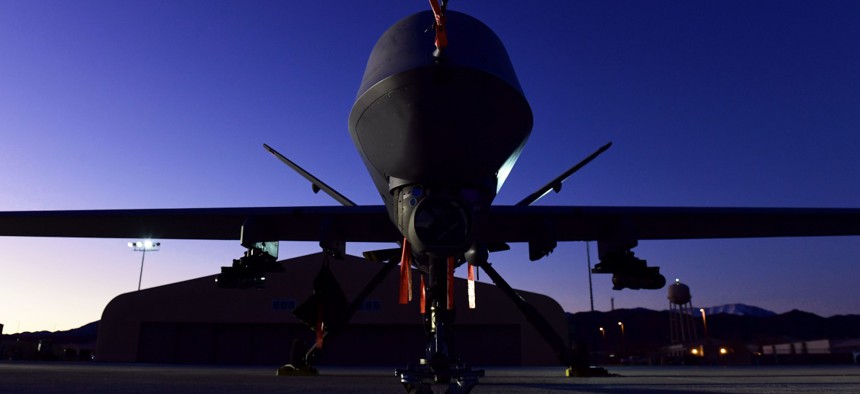Trump Eases Restrictions On Armed Drone Sales Abroad
US says changes needed to compete with China, but critics say it may only alienate allies.
The Trump administration is relaxing arms export restrictions, a move long sought by drone makers but one that critics say will provide little competitive edge to U.S. companies even as it alienates allies.
U.S. drone makers have complained that regulations have allowed China to sell copycat dones to U.S. allies and partners.
“We think this kind of reform is necessary in order to respond to a rapidly-changing technological environment, said R. Clarke Cooper, the assistant secretary of State for political-military affairs, in a statement. “With the growing proliferation of UAS technology, particularly by China, coupled with a growing demand for UAS for both military and commercial applications, we need to adjust U.S. policies to address U.S. national security concerns.”
The changes involve a reinterpretation of the Missile Technology Control Regime, an informal political agreement between 35 countries to limit the proliferation of missiles and missile technology. The MTCR says that large Category 1 drones face the “presumption of denial” for export since they could be used as missiles.
“In a sector of rapidly evolving technology, the MTCR’s standards are more than three decades old,” the White House said in a statement. “Not only do these outdated standards give an unfair advantage to countries outside of the MTCR and hurt United States industry, they also hinder our deterrence capability abroad by handicapping our partners and allies with subpar technology.”
Christopher Ford, assistant secretary of state for international security and nonproliferation, called the change overdue and modest, as it would affect only large, slow-moving drones. Armed drones and drones that travel faster than 800 km an hour, more in line with cruise missiles, would continue to be non-exportable, Ford said Friday at the Hudson Institute.
Cooper told reporters on a Friday conference call that “This policy change, in effect, modernizes our approach to implementing our MTCR commitments, it makes it more reflective of technological realities, it helps our allies and partners It helps them all meet their urgent national security and commercial requirements, and it also advances the United States’ national security and economic interests.”
Ford said the State Department had been pushing for the change since March 2018 but other MTCR members have been resisting it — which has helped China and other countries swoop in and steal market share.
He said that since non-MTCR countries remain free to sell whatever they wish, the categorization of the drones as missiles “represents not only a net loss for those countries that are responsible enough to join the regime but also a net loss for nonproliferation as the market for such low threat systems is effectively ceded to the least responsible international players, those folks who don’t actually worry about those things like MTCR standards.”
Ford described the change as attitudinal. Where the MTCR language now calls for a “strong presumption of denial” for the export of such drones, the United States would, instead, not presume anything for such drones, which, he said, was a matter of “national discretion” and perfectly in line with the guidelines as written. Decisions would still be case-by case. “It has always been possible to make Category 1 transfers when there is a compelling reason to overcome presumption and such a step is well justified in terms of the non proliferation factors that are specified in the MTCR guidelines,” he said.
Experts had mixed predictions about the change’s likely effects on exports and national security. Michael Horowitz, a professor of political science at the University of Pennsylvania, said the change could help U.S. arms makers better compete with China. While the new speed test does not fully fix the fact that the MTCR treats drones as missiles, “the speed test could make the export of current U.S. uninhabited aircraft easier, most prominently the MQ-9 Reaper. China is already exporting uninhabited aircraft throughout the world, including to US allies and partners. It will be interesting to see how the new policy is implemented, and whether it will decrease China’s export edge.”
Rachel Stohl, vice president of the Stimson Center, said the change likely won’t help the U.S. sell more drones since the world is moving from big ones to smaller ones anyway. The only effect of the unilateral change would be alienating important allies. “The policy change will not give the United States more access to markets that the Chinese or Israelis already dominate,” said Stohl. “The global market is increasingly focused on smaller UAVs, where Category I restraints do not apply. The United States has already been overtaken as the dominant drones exporter... The decision further complicates U.S. relationships with multilateral regimes and further isolates the US from its closest allies.”
Defense companies have been pushing for export changes for years so that they can sell more drones overseas, especially in the Middle East.
“A lot of times what our partners [and] allies want, they want [a] weaponized MQ-9 platform,” said David Alexander, president of General Atomics Aeronautical Systems, maker of the MQ-9 Reaper. He spoke July 1 at the Center for Strategic and International Studies. “We’ve got to be able to push that faster.”
Alexander said that once a U.S. partner buys a Chinese drone, it could shut out U.S. companies that want not just to sell weapons but maintain and provision them for decades.
“It’s taking too long right now and we have to somehow get Congressional politics out of this … because if you let China in and, it’s not just the sale it’s you’re giving the market away because they’re going to get a logistics lock with their product for 20 to 30 years,” Alexander said. “Once they’re in, you’re out and I’m not sure that’s fully understood. They’re not buying shoes. They’re buying a system that will last 30 years.”







